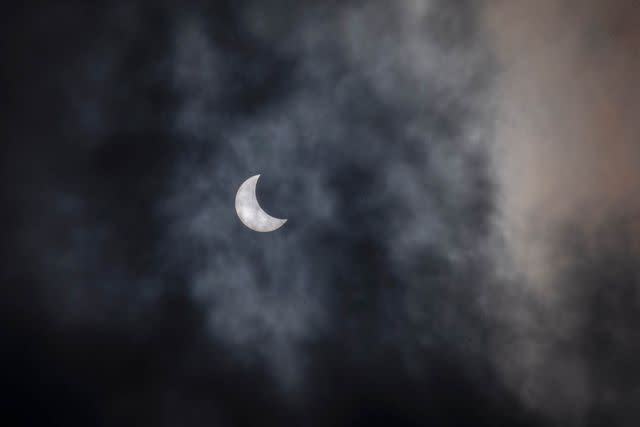A Partial Solar Eclipse is Coming this Week — Here’s How and When to Watch it
Catch the last solar eclipse of the year either in person or on livestream.
Early Tuesday morning, the last solar eclipse of the year will make an appearance — and no matter where you are in the world, there's a way to view it.
Stargazers in Europe, western Asia, and northeast Africa can watch this astro-event in person, according to Space.com, while those those outside the eclipse path — including in the United States — can tune into a livestream for a chance to see the moon partially cover the sun as it travels between Earth and our planet’s closest star.
Here’s everything to know about this month’s partial solar eclipse, including how, when, and where to watch the interstellar magic unfold.

Bivas Shrestha/SOPA Images/LightRocket via Getty Images
What is a partial solar eclipse?
A solar eclipse occurs when the moon crosses between the Earth and sun; as their paths intersect, the moon obscures the latter. It creates a “ring of fire” as the moon perfectly covers the sun with a border of fiery blazes.
Perspective and proximity are key here. The sun and moon both appear around the same size in the sky; that’s why the moon snugly covers our view of the sun during an eclipse. That said, the sun is actually 400 times larger than the moon, according to EarthSky.org. Since it’s 400 times farther away from Earth than the moon, these outer-space objects look similar in size.
During a partial solar eclipse, like the one we’ll welcome on Oct. 25, the moon passes by only part of the sun’s disk. The most dramatic sun covering will take place in the West Siberian Plain, more than 1,000 miles northeast of Moscow, according to Space.com. Up here, the moon will hide 82 percent of the sun.
Where can I watch the partial solar eclipse?
If you’re located in Europe, western Asia, or northeast Africa, the eclipse-sighting odds are in your favor — as long as you have clear skies that don’t obstruct the event. In terms of timing, the eclipse begins in Reykjavik just before 9 a.m. locally, and lasts until 10:35 a.m., according to Space.com. Those in London can start seeing the eclipse around 10 am. local time, while astro-enthusiasts in Egypt can spot it around 12 p.m. local time.
Can’t see it in person? Tune in for a livestream via the Royal Observatory Greenwich, which kicks off early Tuesday morning.
Can I see this week’s partial solar eclipse in the U.S.?
Sadly, this week’s partial solar eclipse is not visible in North America; you can watch it via livestream around 4 a.m. ET. But all is not lost. We have a frenzy of eclipses coming up in the next few years, including the annular solar eclipse on Oct. 14, 2023, and the long-awaited total solar eclipse on April 8, 2024. Both will be visible in North America.
Do I need protective glasses for the solar eclipse?
As with any solar eclipse — or any time looking at the sun — it’s important to protect your eyes. Buy some solar eclipse glasses, or DIY your own viewing device, for safe watching.
For more Travel & Leisure news, make sure to sign up for our newsletter!
Read the original article on Travel & Leisure.

